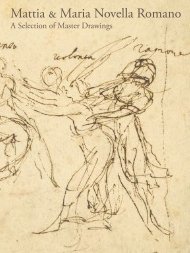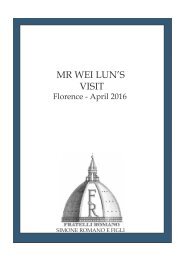A Selection of master drawings 2014
- No tags were found...
You also want an ePaper? Increase the reach of your titles
YUMPU automatically turns print PDFs into web optimized ePapers that Google loves.
7. Carlo Maratta<br />
Camerano (Ancona) 1625 - 1713 Rome<br />
A Draped Male Figure with Amphora<br />
Charcoal heightened with lead white on cerulean laid paper<br />
300 x 181 mm. (11¾ x 7⅛ in.)<br />
Inscriptions<br />
bottom right corner, in ink, Carlo Maratti f.<br />
Provenance<br />
A. Maggiori (L. 3005 b).<br />
According to Giovan Pietro Bellori, his biographer and<br />
friend, Carlo Maratta arrived in Rome at the early age <strong>of</strong><br />
eleven and in 1636 joined the bottega <strong>of</strong> Andrea Sacchi.<br />
He spent his first years in Rome studying the works <strong>of</strong> the<br />
great Renaissance artists. He was particularly inspired by<br />
the work <strong>of</strong> Raphael, whose strain <strong>of</strong> Classicism had a great<br />
influence on his work. At the outset <strong>of</strong> his career Maratta<br />
was also strongly influenced by Sacchi. This is evident in<br />
the style <strong>of</strong> the frescoes (based on his <strong>master</strong>’s cartoons) he<br />
executed for the Baptistery <strong>of</strong> San Giovanni in Laterano<br />
(prior to 1650) and in the Adoration <strong>of</strong> the Shepherds in<br />
the church <strong>of</strong> San Giuseppe dei Falegnami (1650-1551),<br />
the latter being his first religious work in Rome. Following<br />
these, Maratta executed the decorations <strong>of</strong> the chapels <strong>of</strong><br />
San Giuseppe and <strong>of</strong> the Crocifisso in Sant’Isidoro (1653-<br />
1656) and in 1657 he contributed to the fresco cycle <strong>of</strong> the<br />
Galleria <strong>of</strong> Alessandro VII, working under the guidance <strong>of</strong><br />
Pietro da Cortona. Following Sacchi’s death in 1661 and<br />
Berrettini’s in 1669, Maratta became the dominant artistic<br />
figure in Rome. It was during this period that he produced<br />
one <strong>of</strong> his most significant works: the Allegory <strong>of</strong> Clemency,<br />
executed in 1673-75 for the Salone delle Udienze in<br />
Palazzo Altieri, and commissioned by Pope Clement X. In<br />
1686 he was commissioned by Cardinal Alderano Cybo<br />
to paint the fresco for the main altar <strong>of</strong> Santa Maria del<br />
Popolo, which was followed by the Death <strong>of</strong> the Virgin for<br />
the Villa Albani. Towards the end <strong>of</strong> his career he produced<br />
the <strong>drawings</strong> for the statues <strong>of</strong> the Apostles in San Giovanni<br />
in Laterano and the restorations <strong>of</strong> Raphael’s frescoes<br />
at the Farnesina and in the Vatican Stanze. The main<br />
nucleus <strong>of</strong> Maratta’s <strong>drawings</strong> belong to the collections <strong>of</strong><br />
the Kunstmuseum in Düsseldorf, the Accademia <strong>of</strong> San<br />
Fernando in Madrid and the Cabinet des Dessins <strong>of</strong> the<br />
Louvre in Paris. A careful study <strong>of</strong> his oeuvre - a detailed<br />
monograph has yet to be published - reveals that Maratta<br />
was a tireless and prolific draughtsman who employed an<br />
incredible variety <strong>of</strong> styles and techniques in his work. The<br />
surviving examples range from the somewhat convulsive<br />
rapid sketches used to define a general composition (<strong>of</strong>ten<br />
traced in pen), to the fine studies <strong>of</strong> details <strong>of</strong>ten outlined<br />
in red or black chalk, a medium he used throughout his<br />
career. If one compares the <strong>drawings</strong> which can be dated<br />
with security - whether <strong>of</strong> figures, draperies, anatomical<br />
elements (heads, arms, hands, legs or feet) - then it can<br />
be noticed that Maratta’s graphic style evolved and<br />
transformed radically. He substituted the precision and<br />
clarity <strong>of</strong> line, the gentle and s<strong>of</strong>t rendering <strong>of</strong> volumes with<br />
the use <strong>of</strong> chiaroscuro, typical <strong>of</strong> the years prior to the 1660s<br />
with a more dynamic and sharp line and a greater use <strong>of</strong><br />
parallel hatching to define shadows. Upon understanding<br />
the nature <strong>of</strong> Maratta’s stylistic evolution, it becomes<br />
clear that this wonderful Male Figure in black charcoal,<br />
accurately defined in every detail and delicately modulated<br />
with chiaroscuro, can be dated to the years <strong>of</strong> Maratta’s<br />
affirmation as an artist in Rome. This was the period<br />
between the execution <strong>of</strong> the altarpiece <strong>of</strong> the Adoration <strong>of</strong><br />
the Shepherds for the church <strong>of</strong> San Giuseppe dei Falegnami<br />
(1650-1651) and the Visitation, painted between 1656<br />
and 1658 commissioned by Alessandro VII Chigi for the<br />
newly built church <strong>of</strong> Santa Maria della Pace. Nevertheless,<br />
to be even more precise on the dating <strong>of</strong> this work one can<br />
compare the stylistic features <strong>of</strong> the preparatory <strong>drawings</strong><br />
for the paintings dated after the year 1655 which include<br />
the above mentioned Visitation, the Martyrdom <strong>of</strong> St<br />
Andrew (Greenville, USA, Bob Jones University Museum,<br />
1656 circa; see Schaar – Sutherland Harris 1967, nn. 190-<br />
199, 200-208 for the <strong>drawings</strong> in Dusseldorf relating to<br />
both paintings) and the Agony in the Garden (Burghley<br />
House, Lady Exeter Collection, 1656-1657 circa). The<br />
preliminary studies for these paintings are in black chalk





